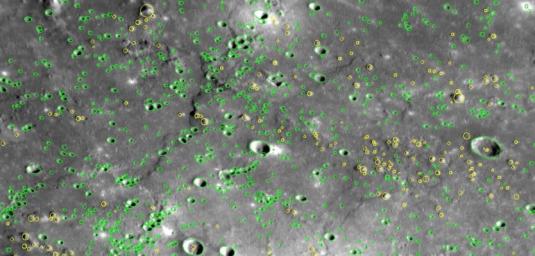
|
Counting Mercury’s Craters
- Click the image above for a larger view
- Full-Res JPEG (1014 x 485) (108.4 kB)
- Full-Res TIFF (1014 x 485) (1.5 MB)
Caption:
On January 14, 2008, MESSENGER flew by Mercury and snapped images of a large portion of the surface that had not been previously seen by spacecraft. Ever since the first images were received back on Earth one day later, January 15, MESSENGER team members have been closely examining and studying this "new" terrain with great interest and excitement.
One of many investigations underway includes identifying and measuring the impact craters on these previously unseen regions. The density of craters on the surface of a planet can be used to indicate the relative age of different places on the surface; the more craters the surface has accumulated, the older the surface. By counting craters on different areas of Mercury's surface, a relative geologic history of the planet can be constructed, indicating which surfaces formed first and which formed later. However, this process is also time consuming; Mercury has a lot of craters! This image shows just a portion (276 kilometers, or 172 miles, wide) of one frame taken with the Narrow Angle Camera (NAC) of the Mercury Dual Imaging System (MDIS). In this image alone, 763 craters have been identified and measured (shown in green) along with 189 hills (shown in yellow). Altogether, 491 frames were taken by the NAC to create high-resolution mosaics of Mercury's surface.
Of course, simply counting the craters is not enough. Each crater has to be measured and classified to fully interpret the differences in crater density. Many small craters form as "secondaries," as clumps of material ejected from a "primary" crater re-impact the surface in the regions surrounding the primary. In order to learn about the history of asteroid and comet impacts on Mercury, scientists have to distinguish between the primary and secondary craters. Once many more craters are measured, MESSENGER researchers will have new insights into the geological history of Mercury.
Image Mission Elapsed Time (MET): 108826672
Background Info:
These images are from MESSENGER, a NASA Discovery mission to conduct the first orbital study of the innermost planet, Mercury. For information regarding the use of images, see the MESSENGER image use policy .
Cataloging Keywords:
| Name | Value | Additional Values |
|---|---|---|
| Target | Mercury | |
| System | ||
| Target Type | Planet | |
| Mission | MESSENGER | |
| Instrument Host | MESSENGER | |
| Host Type | Orbiter | |
| Instrument | Mercury Dual Imaging System (MDIS) | |
| Detector | Narrow Angle Camera (NAC) | |
| Extra Keywords | Color, Comet, Crater, Impact | |
| Acquisition Date | ||
| Release Date | 2008-01-24 | |
| Date in Caption | 2008-01-14 | |
| Image Credit | NASA/Johns Hopkins University Applied Physics Laboratory/Carnegie Institution of Washington | |
| Source | photojournal.jpl.nasa.gov/catalog/PIA10191 | |
| Identifier | PIA10191 | |
